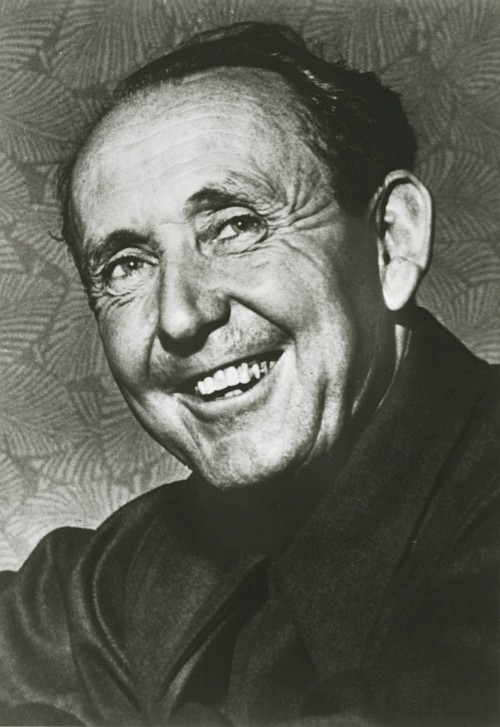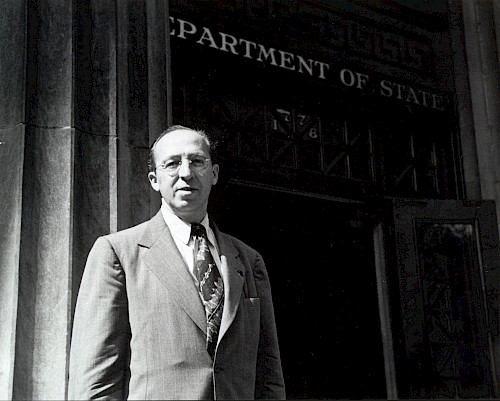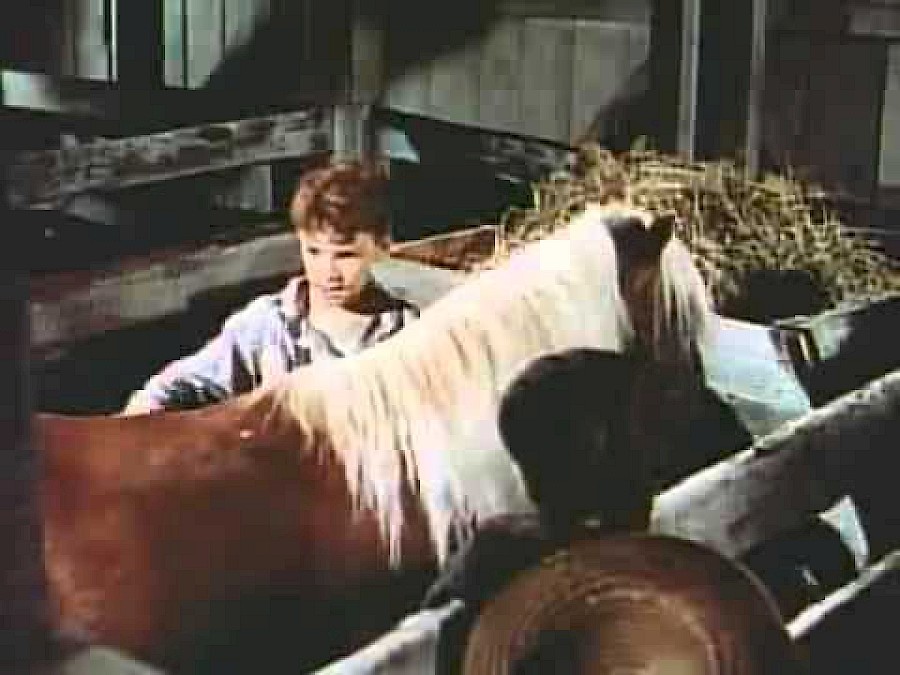Copland seldom wrote about his personal life, or the inner workings of his compositions. But he had a lot to say about being a composer in America. (By America, he usually meant the U.S., though he often expressed solidarity with his Latin American counterparts). He told his own life story several different times, always highlighting his American origins and identity. He spoke often of his desire to write music that sounded American. This article treats a third component of Copland's national identity: his function in American society.
Becoming a composer
As a teenager raised in Brooklyn, Copland surmised that all respected composers were trained in Europe. Rather than seeking a college degree in the U.S., he studied for three years with Nadia Boulanger near Paris. Upon his return to New York City, finding a niche in American society became his most pressing concern. He recalled his initial shock at the dearth of professional opportunities for composers in the U.S., as contrasted with those in Europe.
"Looking backward, I am rather amazed at my own ignorance of musical conditions in America," he wrote. "How a composer managed to get his compositions performed or published and how he was expected to earn his living were equally mysterious."(ONM-MA, 221)
What he meant was that European society had for centuries enabled composers to practice their craft supported by religious institutions, royalty and nobility, civic governments, or other organizations. Because the U.S. lacked Europe's history and cultural traditions, there existed fewer comparable paths for a composer in United States.
Which audience?

The young composer initially connected with American patrons who helped finance his cutting-edge, modernist music for the concert hall. But then the Great Depression hit. At that point, he began seeking a broader base of listeners. "An entirely new public is listening to music," he wrote before the 1930s were out. "This is not a concertgoing public but a public that gets its music through the radio, the phonograph, or even the movies."(ONM, 236)
This new public, he believed, was an American invention, springing from the nation's experiment in government for the people, by the people. "For the first time democracy has entered the realm of serious music," he wrote.(ONM, 236) Strictly speaking, popular support for "serious music" was not entirely new; there had been middle class subscription concerts in England and New England since the early 1800s, when the industrial revolution helped birth a middle class.
Nonetheless, the big audience was considered especially American. Copland once praised Roy Harris's music for its broad, American appeal: "[Harris's] is music that addresses itself to a big public, a sure sign of the composer of a big country."(ONM, 165; TNM, 120)
Reaching audiences
Copland didn't expect the big American audience to embrace the audacious, dissonant music he had written the 1920s. To better connect with society at large, he began to express his creative ideas in a more accessible musical language. As his famous quote from Our New Music goes:
“An entirely new public for music had grown up around the radio and the phonograph. It made no sense to ignore them and to continue writing as if they did not exist. I felt that it was worth the effort to see if I couldn’t say what I had to say in the simplest possible terms. My most recent works, in their separate ways, embody this tendency toward an imposed simplicity."(ONM-MA, 228-229)
Those recent works were The Second Hurricane, Prairie Journal (Music for Radio: Saga of the Prairie), Billy The Kid, and film scores to The City and Of Mice And Men.
In the 1930s, Copland saw clearly that there were multiple American audiences. To be more fully American, he wanted to speak to more of them. "There was a general feeling of reacting against the more high-flown, sophisticated music addressed to a knowing audience and writing something that might be sung by kids or that was going to accompany a movie that anybody might hear and see," he recalled.(Perlis1977, 319)
His "high-flown" comment shows Copland recognized that for many American listeners, European concert music held a certain elitist appeal. "We are the heirs of a colonial people, and because for so long we imported cultural riches from overseas, it became traditional for Americans to think of art as something purchased abroad," he told an audience at the American Academy of Arts and Letters in 1952. Hopefully, he portrayed that view as old fashioned. "Fortunately, there are signs that the notion is slowly dissolving, probably forever, along with other nineteenth-century preconceptions about art in America," he added.(CoM1952, 54)
Political considerations
One component of the "which audience" question was political. Some of the composers who sought to reach a large audience, especially between the world wars, were also sympathetic to political ideologies that were anti-fascist, socialist, and in some cases communist.
In the politically polarized decade after World War II, Copland found it necessary to distance himself from some of his mass audience rhetoric. To do this, he described his move toward "simplicity" in less folksy terms. In 1951, he rephrased industry, commerce, and productivity over singing kids or people on the street. In Music and Imagination (1951) he wrote:
"Sometimes it seems to me that it was the composers who were the very last to take cognizance of a marked change that came over the musical scene after the stimulating decade of the twenties . . . brought about . . . by the introduction . . . of the mass media of distribution in the field of music . . . Composers were slow to realize that . . . they were no longer merely writing their music within an industrial framework; industrialization itself had entered the framework of . . . musical life."(M&I, 107)
Society's part
The responsibility for change lay not with composers alone, in Copland's view. He also insisted that listeners and other participants in "the musical scene"—critics, conductors, concert producers, the recording industry—should meet the composer part way. Society would benefit from rising to meet composers whose art challenged them, Copland implied. The Music and Imagination passage continued: "One of the crucial questions of our times was . . . How are we to make contact with this enormously enlarged potential audience, without sacrificing in any way the highest musical standards?"
Copland became more vocal about what American society should do to welcome its own composers. Critics and listeners and record purchasers must be willing to leave the "musical museum" and give contemporary composers a hearing. The "musical museum" situation that Copland lamented was a particularly American problem. In the absence of the European type of institutional supports for music, Copland and his peers had to rely on the middle-class public. But after World War II, Copland grew increasingly frustrated that the middle-class public, and the music industry in the US, critics, and nearly every segment of society seemed stuck on tried-&-true, safe, crowd-pleasing, European classics, leaving no room for Copland and his peers. Likewise, movie-goers should "Take Off Those Ear Muffs," as the headline read for Copland's 1949 article in the New York Times. Not just audiences, but arts administrators, producers, music critics, and government funding agencies all needed to open their ears to new, American music.
The U.S. Government was part of American society, too, in Copland's eyes. More than once, he publicly called for the government to increase its monetary support for American composers. He acknowledged a prevailing postwar objection that government sponsorship of music could too easily impinge upon artistic freedom, as it had in Nazi Germany and continued to do in the USSR, but countered it with more successful examples, and with an appeal to faith in American democracy.
"Subsidies for the arts in European and Latin American countries are often of an astonishing generosity. They look on us as odd fish for permitting a laissez-aller policy in relation to American art. Surely, in a democracy, where each elected government official is a 'calculated risk,' we ought to be willing to hope for at least as happy a solution as is achieved abroad. Bureaucratic control of the artist in a totalitarian regime is a frightening thing; but in a democracy it should be possible to envisage a liberal encouragement of the arts through allocation of government funds without any permanently dire results."(CoM1952, 58-59)
Representing America
This 1952 speech, later published in Copland on Music, shows a new development in Copland's self-identification as an American composer. Earlier, his priorities had been to carve out a place in American society, to establish an American sound, and to engage with diverse American audiences. Now his emphasis became representing America well on the international stage.

"When I was abroad in 1951, I was aware of a certain reluctance on the part of the ordinary music-lover to believe that America might be capable of producing first-rate work in the field of music. The inference seemed to be that it was unfair for a country to have industrial and scientific power and, at the same time, the potentiality of developing cultural power also. At every opportunity I pointed out that it is just because commercial and scientific know-how alone are insufficient to justify a civilization that it is doubly necessary for countries like the United States to prove that it is possible, at the same time, to produce, along with men of commerce and of science, creative artists who can carry on the cultural tradition of mankind."(CoM1952, 55)
When he spoke these words, he had already traveled abroad several times as a cultural ambassador for the U.S. State Department; this role expanded for Copland in subsequent years.
No matter what connections Copland felt to Western civilization as a whole, by his own estimation, being American was fundamental to his life and work. One of his last autobiographical statements makes this clear. Given the opportunity to reflect on his life of music, he expressed gratitude for the gift of being an American composer.
"I think that my music, even when it sounds tragic, is a confirmation of life, of the importance of life. I would also like to think that my music enlarges the listener's sphere of reference, just as when I listen to a great work by Bach or Palestrina, I have a larger sense of what it means to be alive. Perhaps the answer to why a man such as myself composes is that art summarizes the most basic feelings about being alive. It is very attractive to set down some sort of permanent statement so that people will be able to go to our artworks to see what it was like to be alive in our time and place—twentieth-century America."(Perlis1977, 329)
Sources:
- CoM1952. Aaron Copland, "Creativity in America," presented in May 1952 as The Blashfield Address and published in the proceedings of the American Academy of Arts and Letters and the National Institute of Arts and Letters, Second Series, No. 3. Reprinted in Copland on Music (Garden City, NY: Doubleday: 1960), pp. 51-60.
- CoM1949. Aaron Copland, "The New 'School' of American Composers." Originally published in The New York Times Magazine, March 14, 1948, section 6, p18. Reprinted as "1949: The New 'School' of American Composers" in Copland on Music (Garden City, NY: Doubleday: 1960), pp. 164-175.
- M&I. Aaron Copland, Music and Imagination. Cambridge, Mass: Harvard University Press, 1952.
- ONM. Aaron Copland, Our New Music: Leading Composers in Europe and America. New York: McGraw-Hill, 1941.
- ONM-MA. Aaron Copland, "Composer from Brooklyn" chapter from Our New Music (pp. 212-230) was first published in Magazine of Art 32 (September 1939): pp. 522-523.
- Perlis1977. Aaron Copland and Vivian Perlis. "Aaron Copland: From audio and video interviews with Vivian Perlis, 23 December 1975 to 24 June 1978, Peekskill, New York." In Vivian Perlis and Libby Van Cleve, Composers' Voices from Ives to Ellington: An Oral History of American Music. (New Haven: Yale University Press, 2005), pp. 300-329.
- TNM. Aaron Copland, The New Music. New York: W.W. Norton, 1968.
Further reading
- Ansari, Emily Abrams. 2011. “Aaron Copland and the Politics of Cultural Diplomacy.” Journal of the Society for American Music 5, no. 3: 335–364.
- Chowrimootoo, Christopher; Kate Guthrie, et. al, "Colloquy: Musicology and the Middlebrow," JAMS 73: 2 (Summer, 2020): 327–395.
- Copland, Aaron. “Tip to Movie-goers: Take Off Those Ear-Muffs.” New York Times Magazine, November 6, 1949.
- DeLapp, Jennifer. “Fighting the Musical Museum: Aaron Copland’s Music and Imagination.” In the Arts, Community, and Cultural Democracy, ed. Lambert and Henry Luttikhuizen Zuidervaart: 108-21. London, New York: Macmillan, St. Martin’s Press, 2000.
- DeLapp, Jennifer. “Speaking to Whom?: Modernism, Middlebrow, and Copland’s Short Symphony.” In Copland Connotations: Studies and Interviews, ed. Peter Dickinson: 85-102. Rochester, New York: Boydell Press, 2002.
- Hess, Carol A. Aaron Copland in Latin America. Chicago: University of Illinois, 2023.
- Levy, Beth E. Frontier Figures."Roy Harris: Provincial Cowboy, White Hope" (227-290); "Aaron Copland: From Orient to Occident" (293-368). Berkeley and Los Angeles: University of California, 2012.
- Saavedra, Leonora. “Revisiting Copland’s Mexico.” Paper presented at the Latin American Music Center’s Fiftieth Anniversary Conference “Cultural Counterpoints: Examining the Musical Interactions between the U.S. and Latin America,” Indiana University, Bloomington, 2011. Available from IUScholarWorks (https://scholarworks.iu.edu/dspace/handle/2022/15547); accessed [22 February 2023]
- Weber, William. Music and the Middle Class: The Social Structure of Concert Life in London, Paris and Vienna between 1830 and 1848. Electronic edition. London: Routledge, 2017. https://doi.org/10.4324/9781315090924




